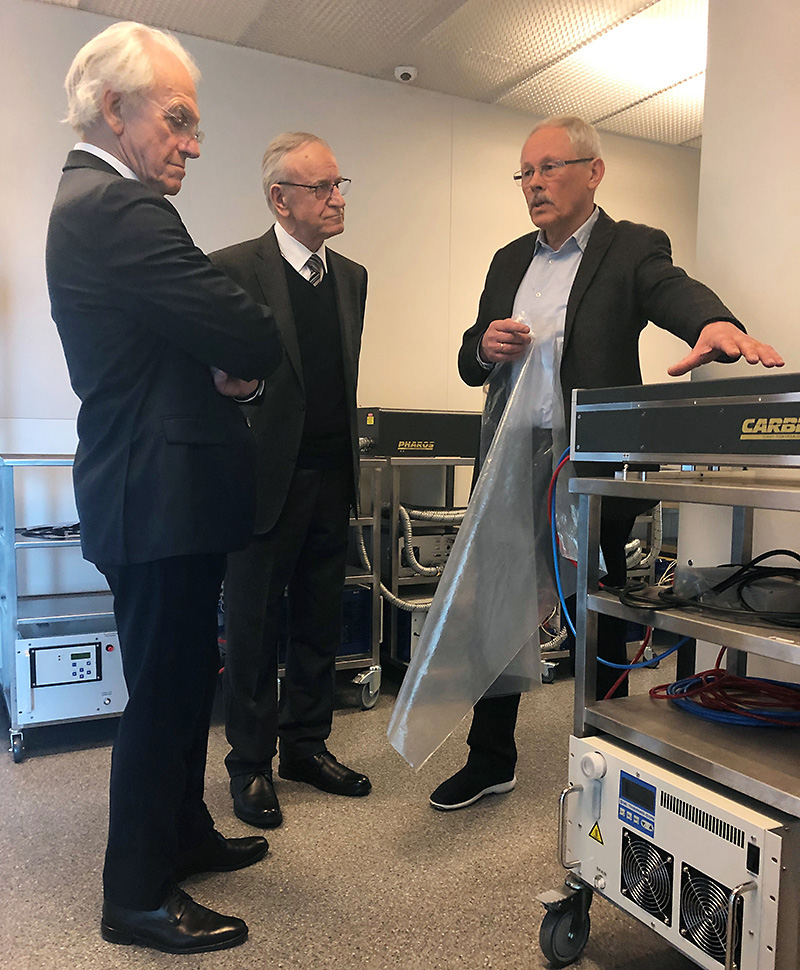Lithuania received a visit of the Nobel Prize winner, the French scientist Professor Gérard Mourou. On 19 March 2019, he was officially inaugurated as a foreign member of the Lithuanian Academy of Sciences.
In 2018, the Nobel Prize in physics was awarded to three scientists – the French scientist prof. Gérard Mourou, the Canadian scientist prof. Donna Strickland, and the American scientist prof. Arthur Ashkin. Gérard Mourou and Donna Strickland received the Nobel Prize for the CPA (Chirped Pulse Amplification) technology. This technology has enabled the development of ultra-high-power short pulse lasers. The research group of prof. Algis Piskarskas from the Laser Research Centre of Vilnius University has also significantly contributed to the victory of G. Mourou and D. Strickland. The work of the Lithuanian scientists was also quoted in the scientific background document of the 2018 Nobel Prize.
Prof. Gérard Mourou has been cooperating with the Laser Research Centre of Vilnius University and prof. Algis Piskarskas since 1992: the CPA modification – OPCPA technology (Optical Parametric Chirped-pulse Amplification) – was invented in Vilnius in the same year. The difference between the technologies invented by the Lithuanian scientists and by the winners of the Nobel Prize is that the technology developed by G. Mourou and D. Strickland cannot operate at a high frequency of repetition (the number of flashes per second).
The OPCPA technology of the Lithuanian scientists, however, can operate at a tremendous frequency as well in the broad range of the various waves lengths. The CPA technology is applied in lasers produced in Lithuania, for example, in PHAROS and CARBIDE lasers manufactured by LIGHT CONVERSION. These lasers are used by the largest research and industry centres around the world – in Germany, Japan, the USA, China and the Great Britain. The lasers operate in the research laboratories of biochemists, physicists and chemists. They are also applied in the industrial machines for drilling, cutting, surface structuring and also for grinding. Lasers are the core of various industrial machines produced by Swiss, German and Japanese manufacturers. Almost all mobile phones contain parts made by PHAROS laser of the Lithuanian origin. The cardiovascular surgeons from all over the world use the components made by PHAROS lasers at their work. There are thousands of vehicles in the world with engine parts processed by using PHAROS laser.
Long-term Cooperation
Prof. Gérard Mourou made substantial efforts for Lithuania to be invited to participate in the initial stage of the Extreme Light Infrastructure in 1998. An introductory project aimed at full membership of Lithuania in the ELI is currently in progress. Laser system made in Lithuania and based on CPA and OPCPA technologies is already operating in the ELI facility in Hungary. Another powerful laser system is currently produced in Lithuania for the Czech ELI facility and it should be one of the most powerful laser facilities in the world.
Cooperation between prof. Gérard Mourou and the Lithuanian researchers and scientists resulted in remarkable benefits to Lithuania. He constantly invites Lithuanian laser specialists to various conferences to deliver key-note reports, consults Lithuanian researchers and doctoral candidates.
The laser technology development industry in Lithuania is a prospective field of industry that has achieved strong positions in the world. It is one of the underlying fields of the Lithuanian economy that closely links the three main chains of the creation of added value – science, innovations, and production. The achievements of the Lithuanian researchers in the field of lasers are particularly appreciated, whereas the production developed by the national laser specialists is demanded across the world.
‘The fact that Professor Gérard Mourou responded to the invitation of students and scientists means that he highly appreciates the achievements in the field of laser science and innovations in Lithuania,’ says the colleague of the guest, prof. Algis Piskarskas. The winner of the Nobel Prize read a plenary lecture at the International Conference for Students and Young Researchers of Physics and Natural Sciences ‘Open Readings’, which was also an inauguration lecture of the foreign member of the Lithuanian Academy of Sciences.

